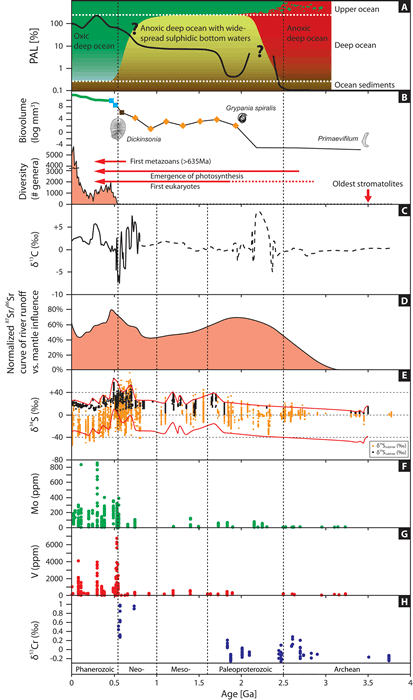
Figure 1.
(A) Proposed reconstruction of atmospheric O2 content through time expressed as percentage of present atmospheric level (PAL) of oxygen (after Canfield, 2005, with Phanerozoic estimates from Berner et al., 2003). Note that the uncertainty is quite high. Background displays redox conditions in the water column whereby the deep ocean was probably anoxic until the Great Oxygenation Event (GOE) in the early Paleoproterozoic, sulfidic during most of the Proterozoic, and primarily oxic after the Neoproterozoic Oxygenation Event (NOE). (B) The NOE possibly unleashed major biological innovations, including the appearance of new biological and ecological strategies: the first metazoans (Hoffman et al., 1990; Love et al., 2009); the appearance of first large and architecturally complex organisms during the Ediacaran (Narbonne, 2005); and the Cambrian Explosion (Marshall, 2006). A pronounced increase of maximum body size by several orders of magnitude occurred between 600 and 450 Ma. Red dots—prokaryotes; orange diamonds—protists; brown square—vendobiont (probable multicellular eukaryote, e.g., Dickinsonia); blue squares—animals; green line—vascular plants (Payne et al., 2009). (C) δ13C record throughout Earth's history (compiled by Campbell and Allen, 2008). (D) Normalized seawater 87Sr/86Sr curve (from Shields, 2007). (E) Compilation of sulfur isotope data measured in sulphide- and sulphate-bearing minerals. Δ34S values in the Archean do not exceed 20‰ and maximal Paleo- and Mesoproterozoic Δ34S values are around 45‰. It is only from the Neoproterozoic on that sulphur fractionation attains values between 40 and 70‰. Upper red curve illustrates maximal d34Ssulfate values and is offset by −55‰ (lower line) (most values were compiled by Canfield and Farquhar, 2009). (F) Compilation of molybdenum concentrations in black shales from different sections around the world (mainly from Scott et al., 2008, and references therein). (G) Compilation of vanadium concentrations in black shales. Precambrian data are rather sparse but still indicate a significant step toward much higher enrichment of V in black shales during the Precambrian-Cambrian transition (Precambrian data mainly from C. Scott, 2010, pers. comm.). (H) Key aspects of the Precambrian history of hexavalent chromium in sea water. Increasing Cr isotope fractionation (δ53Cr) recorded in banded iron formations (BIFs) between 2.8 and 2.45 Ga indicate rise in oxidative weathering with a possible return to reduced atmospheric oxygen levels between 2.45 and 1.9 Ga. BIFs deposited during the late Neoproterozoic between ca. 750 Ma and the Precambrian-Cambrian boundary record strongly positive δ53Cr values ranging from 0.9‰ to 4.9‰, which may provide further evidence for the NOE (from Frei et al., 2009).